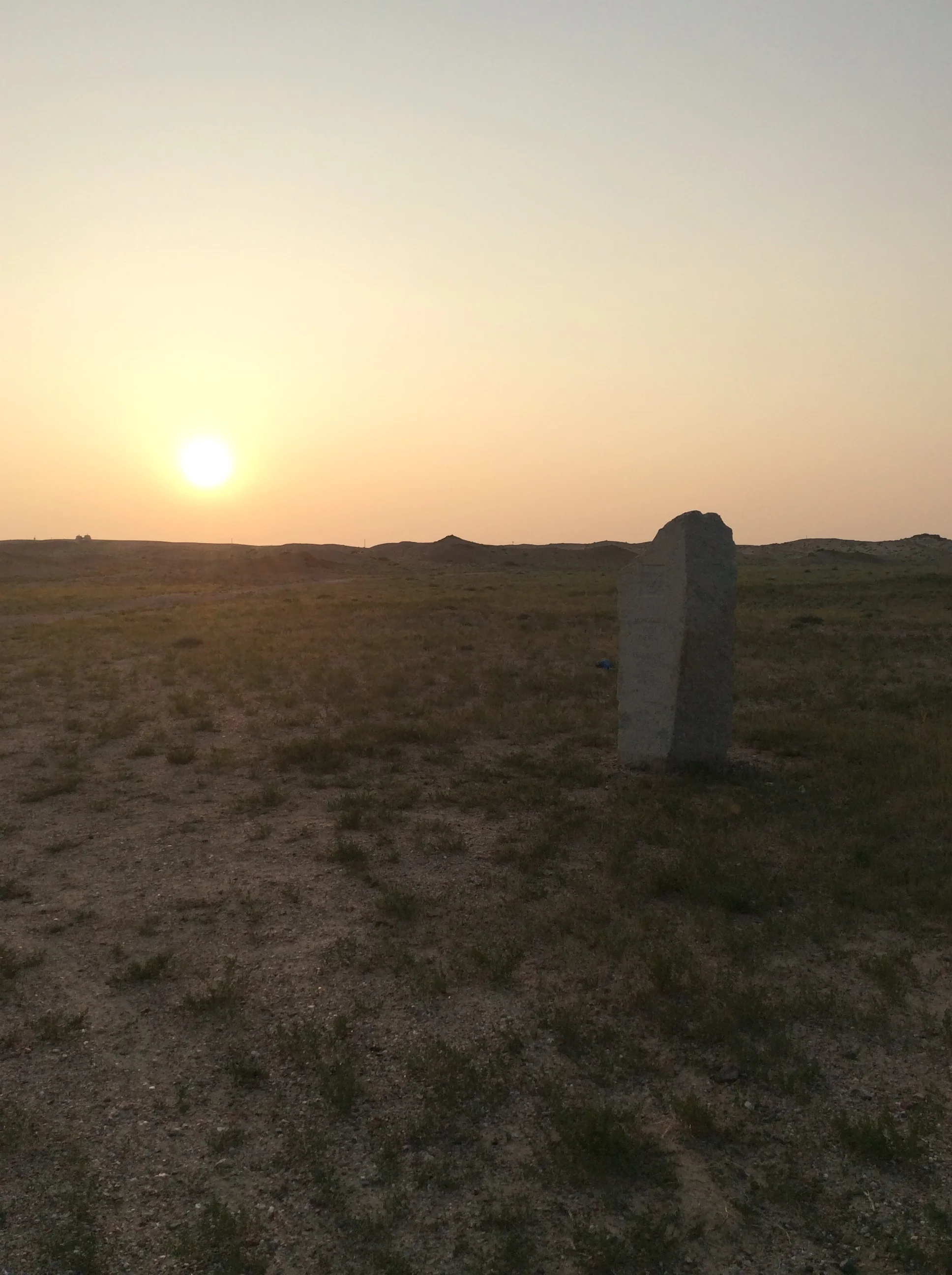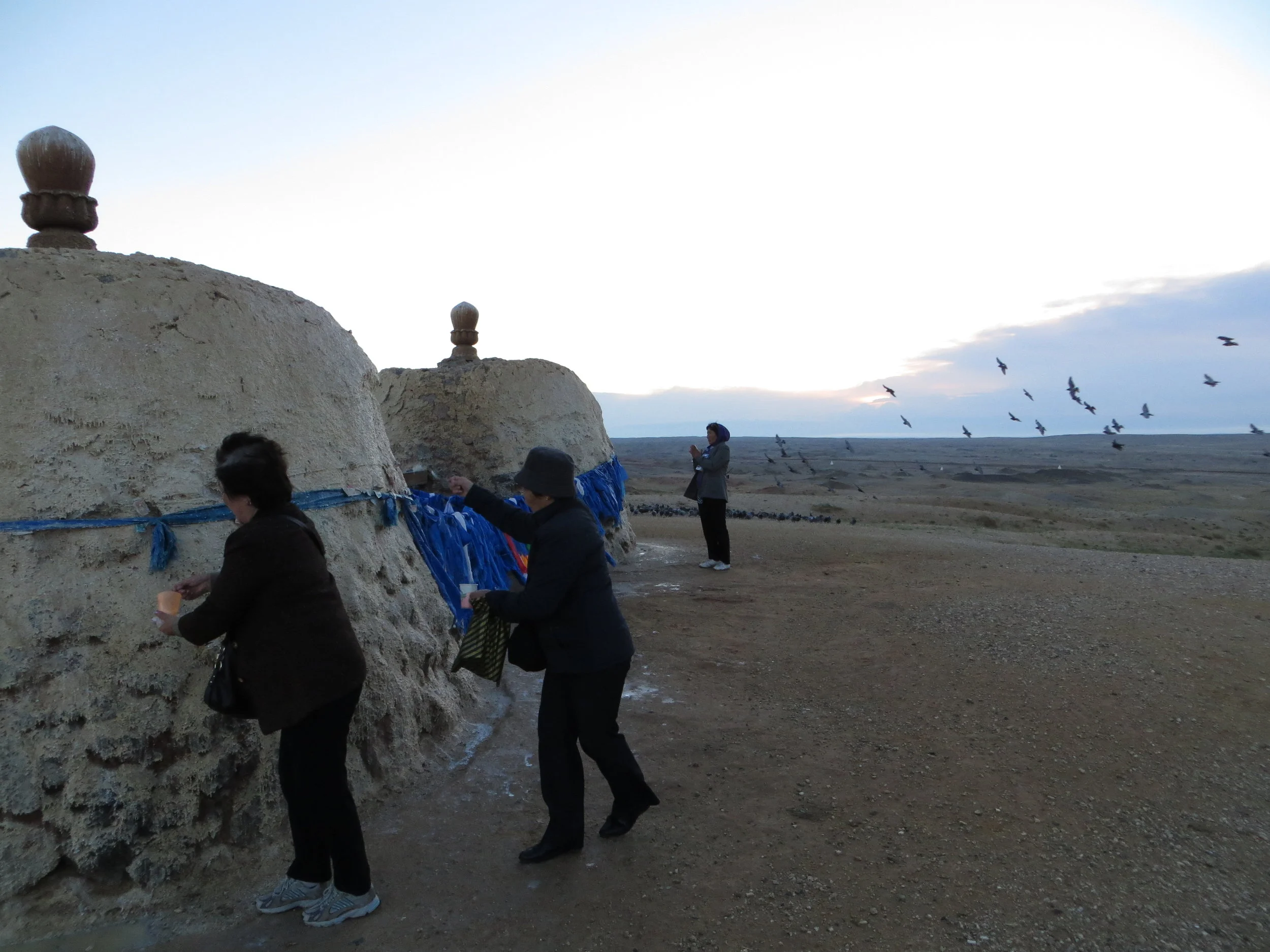Alga Bolokh III / Vom Verschwinden
Wüste Gobi, 2018
Upcoming
Алга болоx / Alga Bolokh
Einladung zu einer Versuchsanordnung über das Verschwinden.
Nähere Informationen und Anmeldung
16. - 18. November; im Rahmen von In_ Forschung im _flieger.
RESEARCH June /July 2018
Alga Bolokh III is the third in a series of interventions developed to deal with endangered places and spaces that are significant for cultural, historic and spiritual reasons.
Making visible the old stories, cultural assets and resulting forms of life in the area, the work exhibits the contrast of the new, rapid process of the digital age, construction of streets and cities, and extraction of resources.
Our upcoming research in Khamaryn Khiid will address this culturally and spiritually significant place in southern Mongolia through its historic, cultural and spiritual dimensions, showing how this heritage site is increasingly endangered by economic and commercial interests.
Khamaryn Khiid, lies on the southeastern edge of the Gobi desert 25 miles south of Shainsand. The first theater in Mongolia originated here in 1820, led by Dulduityn Danzanravjaa, a visionary; spiritual leader, theater and opera director, poet and social reformer. Bringing the idea of an open educated society to life, he was inspired and supported by Daidushari, a dakini, poet, musician and social reformer. The first professional public theater production, The Life of the Moon Cuckoo, was staged on these premises in 1832 with an ensemble of 300 musicians and actors, reaching back to the roots of the ritual Tsam dance. Women in Khamaryn Khiid were not only performing on stage but also embodying male character roles.On the premises of that long since vanished theater, we are planning to create a Storytour - a visual - audio-performance tour, as a continuation of the project Alga Bolokh – On Disappearance I & II (Ulan Bator 2013, Berlin 2014).
One of the core aims of this research and art project is archaeological investigation, with the documentation, archiving and processing of an endangered cultural heritage into a site-specific intervention. A special focus will be on rendering women's voices of the past audible, and thus convey how they saw and engaged with the world.The Storytour is an immediate experience of specific past, the encounter with the constantly changing circumstances of the present moment and the visionary potential for the future of the place.
Drawing on history, geology, theater studies, and the comparative studies of Buddhism and Shamanism, our research is interdisciplinary and juxtaposes current and traditional methods of shamanistic knowledge and practice. The point of departure will be oral and written records, interviews, and extant artifacts as the basis for translating this form into sound and image.
The performance tour, planned for 2019/2020, will consist of a fragmentary narrative inextricably tied to an immediate, visceral experience of the desert, with its continuously shifting visual, acoustic and meteorological phenomena. Each individual participant is immersed in the artistic world of Kharmryn Khiid through the audio/visual performance tour, engaging with the time of Danzanravjaa and Daidushari in the natural stage of the landscape.
PLACE AND CONTEXT
1820 in Khamaryn Khiid was a professional theatre and touring company, public library, museum and a primary and art school for boys and girls. Further three monasteries, ritual places for women, all became local centres of culture, art and education. The primary and art school was unique in pre- revolutionary Mongolia as it offered children a free general, non- religious education.
In 1938, during the Stalinist repressions and purges in Mongolia, virtually all spiritual and cultural places were destroyed, and so was Khamaryn Khiid together with its theater, ritual places, monasteries, museums and schools.
The Curator at the time, G. Tudev, secretly took action to rescue the legacy and packed and removed crates full of books, theatrical costumes, artworks and buried these in various locations in the desert.
The crates remained hidden until 1990 when, with the end of socialist rule in Mongolia, Tudev`s grandson Z. Altangerel, the current gatekeeper of the visionary legacy dug up the objects.
The place is being rebuilt in light of Danzanravjaa's original vision, and the knowledge buried there is gradually unearthed. In the meantime Khamaryn Khiid has become an extraordinary, transnational gathering place for an increasing number of people from all over the world.
LECTURES
International Scientific Conference I Culture World of the Mongols: Heritage, Values and Art I Mongolian State University of Art and Culture, Research Department, Ulaanbaatar, Mongolia. July, 2018
Publication International Conference- Cultural Heritage of Mongolia at the Mongolian State University of Art and Culture. Tomus XXVIII Fasciculus 1- 63 2018,
Lecture im tanz_buero Salzburg, transkulturelle Researchprojekte, 13. October 2018
Labor Im_ flieger in the frame of In_ Forschung, 16. - 18. November 2018
3rd International Conference on Mongolian Buddhism | Research Centre for Mongolian S Studies | Eötvös Loránd University, Budapest, HU, April 2019
International Vienna Mongolian Studies Symposium I DISPERSED AND CONNECTED: MOBILITIES, MATERIATLITIES AND BELONGING(S) IN MONGOLIA AND BEYOND i Weltmuseum Vienna, Austria, 2020
Storytour I First Setch, as part of the Researchproject in July 2018



